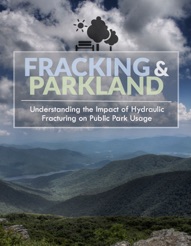Fracking & Parkland
RESEARCH REPORT
Executive Summary
Public parks and recreational facilities are important nodes within multi-scale community systems found across North America, Europe, and Australasia. In addition to offering protections to the environment and wildlife, they provide numerous opportunities for individuals to participate in healthy activities across skill levels and age. The programs and services offered in local, provincial–state, and national parks allow for citizens from diverse population groups to pursue sport, recreation, and leisure (Godbey, Caldwell, Floyd, & Payne, 2005). The preservation and continued accessibility of these spaces—and the natural environments of which they are a part—are therefore paramount to fostering healthy lifestyles and communities.
There is a growing body of literature focused on environmental issues in park management, but this study represents one of the first investigations specifically looking at fracking operations related to park usage and participation. The purposes of this study are to explore the parkland–fracking link and to consider the extent—if any—to which fracking operations taking place in or around designated public parks affect expectations of continued visitation and participation. In other words, if fracking operations were to take place on or near public parkland, how would visitation be affected—or, what do currently active park users predict will happen?
About the Sample
A total of 255 individuals representing five Appalachian states completed the survey. The sample includes Pennsylvanians (42%), Ohioans (28%),Tennesseans (13%), Kentuckians (13%), and West Virginians (3%). Most respondents categorize their community as suburban (52%), followed by rural (26%) and urban (22%). More than half of the sample was female (58%, compared to 42% male). Less than half of respondents (44%) hold a bachelor’s degree or higher, and the average family income falls between $50,000–$74,999. Political affiliations were 42% Democrat, 33% Republican, and 25% something else. Finally, a large majority consider themselves to be either active or passive environmentalists (62%), while 35% did not.
All respondents are park users. Each survey taker reported visiting a local, state, or national park at least once per year, with more than 40% visiting at least once per month.The most popular type of park is local (46%), then state (41%), then national (13%). The most popular park activities are relaxation, picnicking, and running or walking for fitness.
Key Findings
Most respondents expressed familiarity with the process of hydraulic fracturing. More than 60% reported being either somewhat familiar or very familiar with the term “hydraulic fracturing”; on the other hand,10% had never heard of the term before taking the survey. Nearly one-third of the sample lives in a region impacted (either currently or expected to be) by fracking. Most respondents (40%) oppose fracking in any form, while 23% are supportive, 25% are on the fence, and 12% are unsure.
Park users are concerned fracking that occurs on or near their public parks will negatively impact their participation. Only one-third of participants indicated their willingness to participate in recreational activities near fracking operations (33%, compared to 38% unwilling and 29% neutral). More than half of all respondents expressed: concern that a fracking operation would limit their ability to access their park (52%); willingness to travel further to visit a park unaffected by fracking (56%); and support for legislation prohibiting fracking near their favorite park (58%).
In general, park users believe that fracking on public land is unnecessary and bad for the environment. More park users agree fracking on public land is bad for the environment (48%) than those who agree fracking has no impact on the environment (16%). More park users also support banning fracking on public land (46%, as opposed to 20% who agree with promoting it). 50% of respondents believe fracking on public land should be subject to greater oversight and regulation, while 13% believe it should be subject to less oversight and regulation. When neutral responses are removed from calculation, the contrasts are much starker.
While park users generally hold strong opinions that fracking has a negative impact on the natural environment, most park users surveyed for this study are less critical when it comes to its economic benefits. Park users attitudes toward the economic impact of fracking on public land were far more neutral (e.g., regarding its contribution to traffic and gas prices), and in some cases, were positive (such as its impact on the creation of temporary jobs).
Research Team
Tim Kellison, University of Florida, Department of Tourism, Recreation & Sport Management
Kyle Bunds, North Carolina State University, Department of Parks, Recreation & Tourism Management
Josh Newman, Florida State University, Department of Sport Management
Understanding the Impact of Hydraulic Fracturing on Public Park Usage
